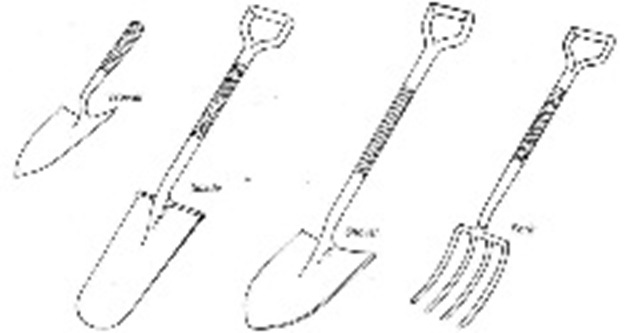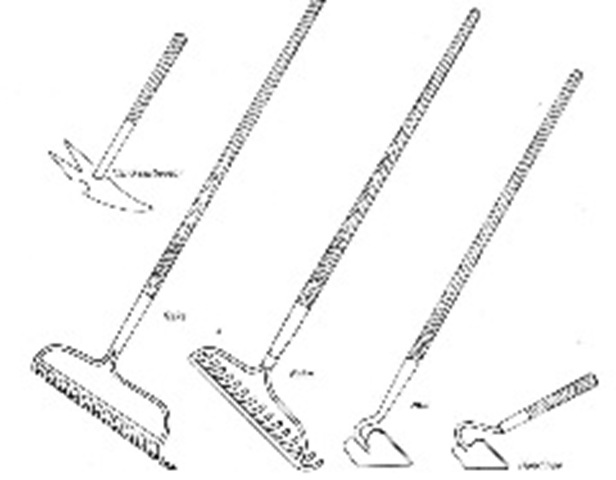The following are the basic tools of the gardener. You may not need them all. Consider the type and amount of gardening you do, and choose the implements that best suit your needs.
Shovel and spade.
A shovel has a curved scoop and a handle with a handgrip. It’s used for lifting, turning, and moving soil. A spade is a sturdy tool with a thick handle (and a handgrip) and a heavy blade that you press into the ground with your foot. The blade is usually flatter and sharper than the shovel’s, and often squared off at the bottom. A spade is for hard digging work; it should be strong but light enough to handle comfortably. A nursery shovel or nursery spade is an excellent all-around tool in the vegetable garden.
Spading fork.
A spading fork is also used for heavy digging, and its two to four prongs make it the best

tool for breaking up compacted soil, lifting root vegetables, and digging weeds. The handle is sturdy and has a handgrip; your foot presses the prongs into the ground. Forks with flexible prongs are called pitchforks; the ones with sturdier, rigid prongs are called spading forks.
Rake.
A rake with a long handle and short sturdy metal prongs is used for leveling and grading soil, stirring up the soil surface, and removing lumps, rocks, and shallow-rooted weeds. It’s an essential tool for the home gardener. You can also get rakes with longer, flexible fingers. This type is not as versatile as the first type, but it’s good for gentle cultivating, cleaning-up chores like raking the leaves, and collecting trash from between plants.
Hoe.
The hoe is a tool with a flat blade attached at right angles to a long handle. It’s used for stirring or mounding the soil and for making rows, and it’s one of the gardener’s most necessary tools. It’s also used for cutting off weeds and cultivating.
Trowel.
This is a short-handled implement with a pointed scoop-shaped blade. It can be used as a hand shovel or spade and is useful when transplanting young plants into the garden.
Hose.
A garden hose is essential for carrying water to your garden. Hoses are usually made from rubber or vinyl; rubber is more expensive, but it’s worth the initial extra cost because it’s far more durable than vinyl and much easier to work with. Make sure your hose is long enough to reach comfortably to all parts of your garden. An effective hose should probably be no less than 50 feet long.

Choose the planter best suited to your needs.
Planting row guide.
A row guide is simply two stakes with a line marked at six-inch intervals stretched between them. It helps you mark straight rows and plant seeds or plants evenly and quickly. A row guide you make yourself works every bit as well as an expensive store-bought one. To make your own, just tie a good string line (as long as your garden at its longest point) between two stakes, and mark the line every six inches with colored markers. Come planting time,setup your guide and piant along it.The straight rows of plants you get when you use a guide are easier to weed, water, and harvest than random plantings.
Plant cages.
Although these are commonly referred to as tomato cages, you can also use them to support vining crops like cucumbers and squashes. They’re usually made of wire or covered wire and come in a variety of sizes. They contain the plant in a manageable space and keep it off the ground. Round cages are the most common, but you can now buy square ones that are a lot more convenient because they fold flat for storage. When you’re buying cages, make sure that they’re big enough and sturdy enough for the plant variety and that you can get your hand inside to harvest your crop.
